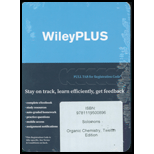
Concept explainers
Interpretation:
The optically active compounds among the given compounds are to be identified.
Concept introduction:
The molecules that are non-superimposable or not identical with their mirror images are known as chiral molecules.
A pair of two mirror images that are non-identical is known as a pair of enantiomers, and these are optically active.
The enantiomers in which the path traced from the highest to the lowest
The enantiomers in which the path traced from the highest to the lowest atomic number is in the clockwise direction are designated as
The objects or molecules which are superimposable with their mirror images are achiral objects or molecules. These objects have a centre of symmetry or plane of symmetry.
The achiral compounds in which the plane of symmetry is present internally and consists of chiral centres are known as meso compounds, but they are optically inactive.
Want to see the full answer?
Check out a sample textbook solution
Chapter 5 Solutions
ORGANIC CHEMISTRY-WILEYPLUS ACCESS PKG.
- 2.35 Consider 1-bromo-2-methylpropane and draw the following.(a) The staggered conformation(s) of lowest energy(b) The staggered conformation(s) of highest energyarrow_forwardRefer to the list of compounds shown below when answering questions 4(a) to 4(j) (a) A 50:50 mixture of structure VI with what other compound would lead to a racemic mixture?(b) Identify one compound that is identical to structure IV. (c) Identify one compound that is identical to structure V. (d) Identify one compound that is expected to have identical physical properties as structure II. (e) Other than structures III and VI, identify a stereoisomer with a different boiling point from that of structure II. (f) Other than structures IV, identify one diastereomer of structure I. (g) How many stereoisomers may be derived from structure V? (h) Specify the absolute (R/S) configuration of the amino group in structure IV. (i) If the substituents in structures I, IV and V were identical (all OH or all NH2), which structure would result in a meso compound? (j) If each hydroxy group for structures I, II and VI were replaced with another amino group, which compound would be made optically…arrow_forwardDraw a bond-line diagram for the compounds below. Which of the following compounds is chiral? (a) 2-bromobutane (b) methylcyclohexane (draw a chair configuration)arrow_forward
- Which of (a)-(d) is not aromatic? (B) (A) (C) (D)arrow_forwardPRACTICE PROBLEM 2.2 The compounds in each part below have the same (or similar) molecular weights. Which compound in cach part would you expect to have the higher boiling point? Explain your answers. (a) OH or (c) OH or HO (b) (CHN or A factor (in addition to polarity and hydrogen bonding) that affects the melting point of many organic compounds is the compactness and rigidity of their individual molecules. • Molecules that are symmetrical generally have abnormally high melting points. sert- Buryl alcohol, for example, has a much higher melting point than the other isomeric alcohols shown here: OH OH tert-Butyl alcohol (mp 25 "C) Butyl alcohol (mp -00 "C) Isobutyl alcohol sec-Butyl alcohol (mp 108 C) (mp-114 C) о оarrow_forward2.(a) Different conformations are found in 2-methylpentane. (i) Using Newman Projection, draw all the possible staggered and eclipsed conformations of pentane by referring to the bond rotation at C3-C4.(ii) Compare their stability and explain your answer.arrow_forward
- Which is aromatic? (3)arrow_forwardWrite structural formulas for all the constitutionally isomeric compounds having the given molecular formula.(a) C4H10(b) C5H12(c) C2H4Cl2(d) C4H9Br(e) C3H9Narrow_forward2.34 Consider 1-bromopropane, CH3CH2CH2Br.(a) Draw a Newman projection for the conformation in which !CH3 and !Br are anti (dihedral angle 1808).(b) Draw Newman projections for the conformations in which !CH3 and !Br are gauche (dihedral angles 608 and 3008).(c) Which of these is the lowest energy conformation?(d) Which of these conformations, if any, are related by reflection?arrow_forward
- Write structural formulas for all the constitutional isomers of (a) C3H8 (b) C3H6 (c) C3H4arrow_forwardWhat is the correct IUPAC name for Cr₂O₃? (I) (II) (III) (IV) tri- di- penta- mono- tetra- hexa- hepta- octa- carbon oxate chromate chromium oxygen oxide peroxide hydrate acid Deletearrow_forwardProvide the correct IUPAC name for N₂Br3. (1) () () (IV) tri- di-penta-tetra- mono- hexa- octa- hepta- bromite nickel bromide nitrogen niobium bromate hydrate acid Deletearrow_forward
 ChemistryChemistryISBN:9781305957404Author:Steven S. Zumdahl, Susan A. Zumdahl, Donald J. DeCostePublisher:Cengage Learning
ChemistryChemistryISBN:9781305957404Author:Steven S. Zumdahl, Susan A. Zumdahl, Donald J. DeCostePublisher:Cengage Learning ChemistryChemistryISBN:9781259911156Author:Raymond Chang Dr., Jason Overby ProfessorPublisher:McGraw-Hill Education
ChemistryChemistryISBN:9781259911156Author:Raymond Chang Dr., Jason Overby ProfessorPublisher:McGraw-Hill Education Principles of Instrumental AnalysisChemistryISBN:9781305577213Author:Douglas A. Skoog, F. James Holler, Stanley R. CrouchPublisher:Cengage Learning
Principles of Instrumental AnalysisChemistryISBN:9781305577213Author:Douglas A. Skoog, F. James Holler, Stanley R. CrouchPublisher:Cengage Learning Organic ChemistryChemistryISBN:9780078021558Author:Janice Gorzynski Smith Dr.Publisher:McGraw-Hill Education
Organic ChemistryChemistryISBN:9780078021558Author:Janice Gorzynski Smith Dr.Publisher:McGraw-Hill Education Chemistry: Principles and ReactionsChemistryISBN:9781305079373Author:William L. Masterton, Cecile N. HurleyPublisher:Cengage Learning
Chemistry: Principles and ReactionsChemistryISBN:9781305079373Author:William L. Masterton, Cecile N. HurleyPublisher:Cengage Learning Elementary Principles of Chemical Processes, Bind...ChemistryISBN:9781118431221Author:Richard M. Felder, Ronald W. Rousseau, Lisa G. BullardPublisher:WILEY
Elementary Principles of Chemical Processes, Bind...ChemistryISBN:9781118431221Author:Richard M. Felder, Ronald W. Rousseau, Lisa G. BullardPublisher:WILEY





